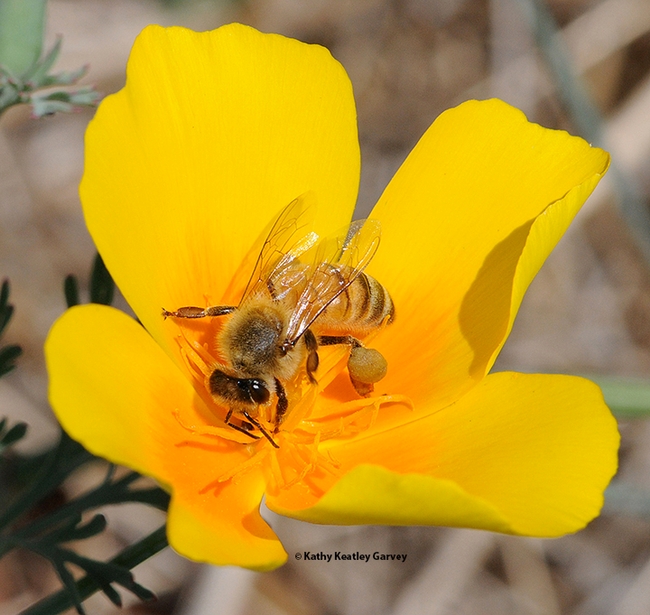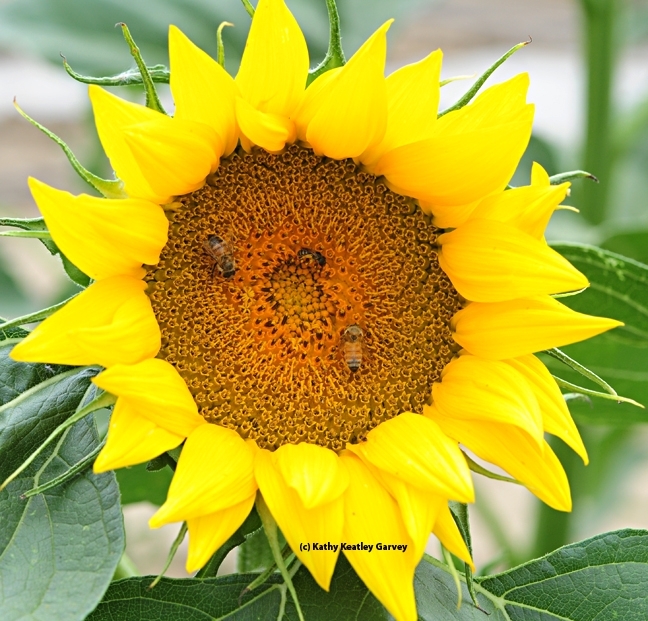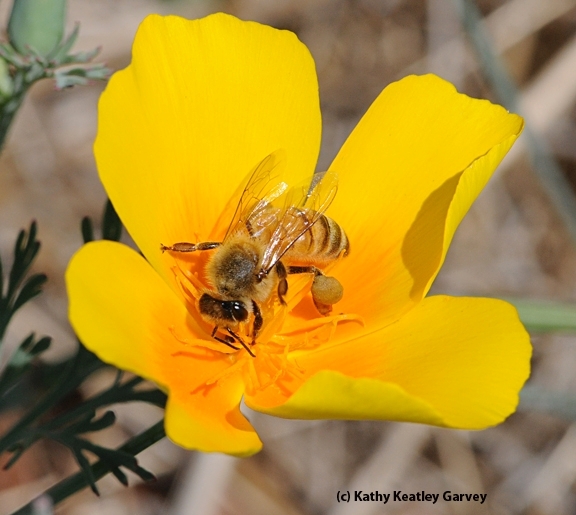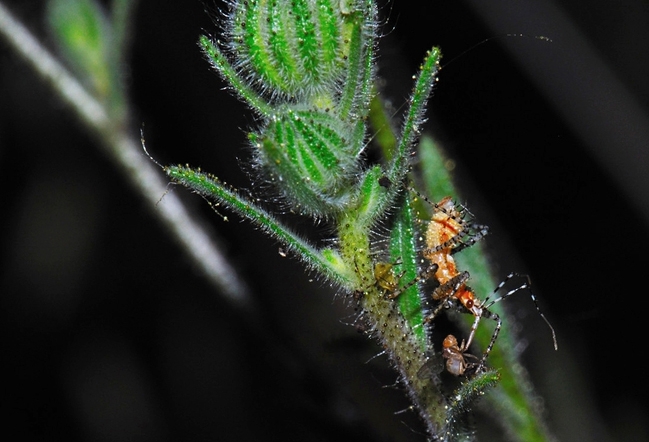- Author: Kathy Keatley Garvey

Those who live in the Sacramento area (including Davis) and the East Bay, are invited to register for the citizen scientist project sponsored by UC Davis doctoral alumnus Billy Krimmel, ecologist and founder of Miridae Living Labs, West Sacramento.
The goal: to see the dynamics of native plant seed dispersal in human-dominated landscapes. "Sign-ups are open until mid-January or until we run out of seed packets!" said Ashley Hong, Seed Pile Project intern.
Miridae has extended the time frame from December to mid-January to drop the seeds.
Miridae is working with pollination ecologist Neal Williams, professor, and urban landscape entomologist Emily Meineke, assistant professor. Also on the team is assistant professor Haven Kiers of the Department of Human Ecology, who specializes in landscape architecture and environmental design.
Here's what you do:
- You sign up here
- You get 3 free packets of native wildflower seeds
- You drop them somewhere in your neighborhood or commute
- You DO NOT water or maintain them
- You monitor them once a month until May using the Miridae app and "tell us what you see"
"We encourage folks of all ages to participate, and we provide resources such as seedling identification guides to help you identify the species in your seed piles," Krimmel told us. "This is a great project for school classes and scout troops in addition to individuals."
It works like this: "Community participants to drop small piles of local, California native seeds in urban areas where they live or work, then monitor the results through repeated observations," as Krimmel explained. "Using data from participants on the conditions under which certain species of these locally adapted seeds spread, survive, or die, we can gain a better understanding of which native species to incorporate into the built environment and where to put them for the greatest ecological benefit and resilience."
What's in the wildflower mix?
Sacramento Region seed mix:
- Eschscholzia californica, California poppy
- Phacelia imbricata, Imbricate phacelia
- Clarkia unguiculata, Elegant clarkia
- Lupinus microcarpus var. densiflorus, Dense-flowered lupine
- Madia elegans, Common madia
- Helianthus annuus, Sunflower
- Nemophila menziesii, Baby blue eyes
East Bay Region seed mix:
- Eschscholzia californica, California poppy
- Phacelia californica, Rock phacelia
- Hemizonia congesta ssp. luzulifolia, Hayfield tarweed
- Clarkia purpurea, Purple clarkia
- Lupinus bicolor, Miniature lupine
- Nemophila menziesii, Baby blue eyes
Happy seed-piling!


- Author: Kathy Keatley Garvey

If you live in the Sacramento area (including Davis) and the East Bay, ecologist Billy Krimmel, a UC Davis doctoral alumnus and founder of Miridae Living Labs, invites you to participate.
- You sign up here
- You get 3 free packets of native wildflower seeds
- You drop them somewhere in your neighborhood or commute
- You DO NOT water or maintain them
- You monitor them once a month until May using the Miridae app and "tell us what you see"
It works like this: "Community participants to drop small piles of local, California native seeds in urban areas where they live or work, then monitor the results through repeated observations," Krimmel said. "Using data from participants on the conditions under which certain species of these locally adapted seeds spread, survive, or die, we can gain a better understanding of which native species to incorporate into the built environment and where to put them for the greatest ecological benefit and resilience."
"The basic goal is to learn which species can thrive in human-occupied spaces, especially transportation corridors," said Krimmel, who received his doctorate in ecology in 2015, studying native plant-insect interactions with major professor Jay Rosenheim, distinguished professor of entomology. "This year we are collaborating with UC Davis entomologists who will use these seed piles to learn about how certain urban conditions impact native bee species."
Miridae will be working with two UC Davis Department of Entomology and Nematology faculty, pollination ecologist Neal Williams, professor, and urban landscape entomologist Emily Meineke, assistant professor. Also on the team is assistant professor Haven Kiers of the Department of Human Ecology, who specializes in landscape architecture and environmental design.
"We encourage folks of all ages to participate, and we provide resources such as seedling identification guides to help you identify the species in your seed piles," Krimmel said. "This is a great project for school classes and scout troops in addition to individuals."
The seed packets will contain Arroyo Lupine, California golden poppy, Phacelia ciliata, Bolander's sunflower, Madia elegans and Nemophila.
A kickoff gathering is set from 4 to 7 p.m., Thursday, Nov. 17 at the Jackrabbit Brewing in West Sacramento where participants can pick up their seed packets, meet other participants, and perhaps buy a native plant and/or beverage. "There will be other pickup options as well," he said.
Krimmel founded the company, located at 1385 Terminal St., West Sacramento, with the intention of “creating habitat for native species within human-occupied areas and engaging people with the species interactions occurring in these habitations.” Its mission: "To strengthen connections between people, native plants, and wildlife through design, construction, outreach and research."
The name, Miridae, is Latin for a family of insects known as “plant bugs,” or mirids, which Krimmel researches. One of the most well-known mirid is the lygus bug, a serious pest of cotton, strawberries and alfalfa.
Miridae won the highly competitive 2020 Award of Excellence for Communication from the American Society of Landscape Architects (ASLA) for its Seed Bank Living Wall at DPR Construction, Sacramento. The ASLA awards, judged by a jury of professionals, honor the best in landscape architecture from around the globe.
Of his company, Krimmel says: “We create habitat for, and engage people with, native plants and the wildlife they support. We do this by tying together design, science, and high-quality construction to create landscapes that are beautiful, resilient, and ecologically powerful.” His goal, with each project, is to “come one step closer to creating a network of habitat gardens and migration corridors to support resilient populations of native species.”
Krimmel may be reached via his website www.miridae.com or on Instagram.

- Author: Kathy Keatley Garvey

Or more precisely, dead fruit flies or carrion on a tarweed plant can benefit the plant in more ways that most people would ever think about, say researchers in the UC Davis Department of Entomology.
Just as human tourists can be good for the economy, ‘insect tourists” can be good for a plant.
When the hairs of a “sticky plant” trap small insects or “insect tourists,” the “tourist trap” provides food for other predators, thus becoming a defensive mechanism that spares the plant from increased herbivore damage. Other beneficial results include greater plant fitness and increased fruit production.
“We conducted a large, simple field experiment to test the hypothesis that plant-trapped insects could enhance indirect defense by increasing predator densities,” said ecologist Billy Krimmel, a graduate student in the Jay Rosenheim lab, who worked with fellow ecologist Ian Pearse of the Richard Karban lab. Pearse is now a postdoctoral fellow in Walter Koenig’s laboratory at Cornell University, Ithaca, N.Y.
“Sticky plants-- those producing resinous, oily or hooked trichomes (hairs)--often entrap small insects that land on them as they pass by,” Krimmel said. “This insect carrion functions as a type of plant-provided food for defense.”
“This is the first example of such a plant-provided food being captured from the external environment,” Krimmel said. “We coined the term 'tourist trap', referring to the sticky hairs that catch insect passers-by.”
In their research, “Sticky Plant Traps Insects to Enhance Indirect Defence,” published in the journal Ecology Letters, the ecologists revealed that the trapped insect tourists “increased the abundance of a suite of predators, decreased herbivory and increased plant fitness.”
Later the journal Nature focused on the Krimmel-Pearse research in its ecology section: "When Plants Run the Food Chain."

"We have known for a long time that carnivorous plants entrap insects for their own benefit,” Pearse said. “In our current study, we found that the entrapment of insects by plants might be even more important and general than previously thought."
Krimmel and Pearse conducted their research in the Stebbens Cold Canyon Reserve, a UC Davis Nature Reserve located in Solano County, near the outlet of Lake Berryessa. Their sticky plant was tarweed (Madia elegans), an annual flowering California native plant in the family Asteraceae. It generally flowers in mid to late summer, from approximately June through September.
At our study site, tarweed's major herbivore is the specialist caterpillar Heliothodes diminutiva, which feeds largely on plant reproductive organs and can completely sterilise its host plants,” they wrote. The adult owlet moth, Heliothodes diminutive, lays its eggs on the developing buds. The emerging caterpillars can quickly devour all the flowers and buds.
“The suite of predators commonly found on tarweed,” they wrote, “includes the assassin bug Pselliopus spinicollis, two stilt bugs Hoplinus echinatus and Jalysus wickhami, the green lynx spider Peucetia sp. and the crab spider Mecaphesa schlingeri. All can navigate tarweed's sticky surface.”
Krimmel and Pearse chose 82 tarweed plants for their experiment. They placed dead Drosophila fruit flies to half of them, five flies per week through the growing season, and then monitored all the plants throughout the growing season.
“Because tarweed is a small, annual plant, we were able to do full counts of arthropods on all plants each week, and measure lifetime fruit production by the plants, allowing us to relate our experimental treatment to plant lifetime fitness,” the authors wrote.
“The addition of 5 dead fruit flies (carrion) to plants each week over the growing season increased the abundance of all surveyed predatory arthropods associated with M. elegans plants by 76 percent to 450 percent,. For P. spinoicollis, the most abundant predator, this effect was strongest during the early growth season in June and July.”
Specifically, “the addition of carrion (fruit flies) to M. elegans plants produced a 60 percent decrease in bud damage caused by H. diminutiva, the dominant lepidopteran herbivore in this system and increased lifetime fruit production by 10 percent,” the researchers said.
Jay Rosenheim's USDA research grant helped fund the project. Krimmel received two other grants: a National Science Foundation/Graduate Research Fellowship and a Jastro-Shields Research Scholarship.




